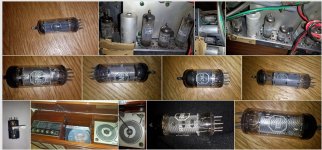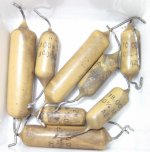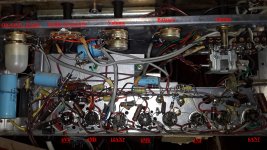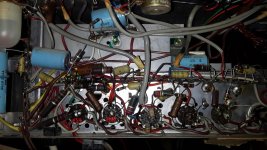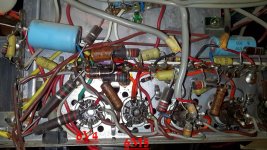Hello people!
first of all sorry for my English, i hardly know English
second.. please excuse me i have minimal knowledge in electronics..
Ok here it goes:
I got an old radiogram "Keisler" made. model 11-109
electric diagram: http://www.kevinchant.com/uploads/7/1/0/8/7108231/11-98a11-104_11-109_11-114.pdf
at the beginning no sound came from the radio, and in addition the turntable didn't spin.. after cleaning the turntable and cleaning the valve tubes i got the radio sound loud and clear, but the record player has poor sound. when i say poor i mean the volume. i turn the volume to 100% in order to hear hardly anything
(i replaced a new needle)
ok my Q are:
1. what can be the reason for the record player sound problem?
2. can it be the cartridge? (its a vintage BSR C1 type, made in England which i can't find anywhere)
3. after cleaning the tubes the radio start working with clear and loud sound (personally i don't see the connection (if there is any) between cleaning the dust from those glass tubes and fixing my sound problem, but after all - taking them out , cleaning them, and putting them back again made it work) so - is there a connection?
4. according to the diagram i attached are there any tubes that controls ONLY the record player sound and maybe i need to replace them? if so - how can i know which one ? how to tell if they work or not?
thank you so much
I'm scratching my head to much on this..
first of all sorry for my English, i hardly know English
second.. please excuse me i have minimal knowledge in electronics..
Ok here it goes:
I got an old radiogram "Keisler" made. model 11-109
electric diagram: http://www.kevinchant.com/uploads/7/1/0/8/7108231/11-98a11-104_11-109_11-114.pdf
at the beginning no sound came from the radio, and in addition the turntable didn't spin.. after cleaning the turntable and cleaning the valve tubes i got the radio sound loud and clear, but the record player has poor sound. when i say poor i mean the volume. i turn the volume to 100% in order to hear hardly anything
(i replaced a new needle)
ok my Q are:
1. what can be the reason for the record player sound problem?
2. can it be the cartridge? (its a vintage BSR C1 type, made in England which i can't find anywhere)
3. after cleaning the tubes the radio start working with clear and loud sound (personally i don't see the connection (if there is any) between cleaning the dust from those glass tubes and fixing my sound problem, but after all - taking them out , cleaning them, and putting them back again made it work) so - is there a connection?
4. according to the diagram i attached are there any tubes that controls ONLY the record player sound and maybe i need to replace them? if so - how can i know which one ? how to tell if they work or not?
thank you so much
I'm scratching my head to much on this..
I think first I would clean the rotary switch that switches between the radio and TT then the plug and jack for the multi pin connection from the tone arm to amp and lastly I would check the contacts in the 2 auxiliary input jacks(at least that what the schematic looks like) in line with phono input cables...
Regards, Elwood
Regards, Elwood
What I would do is to check C21 and C22 and in most cases they will need to be replaced otherwise they will destroy the audio transformer and valves. Perhaps also replace C25 and C26 but these are less important.
There is only one safe type of capacitor that rarely needs to be changed out.
These are known as Mullard Mustard capacitors and hardly ever fail. Check that they are the type shown in the photo and replace them if they are not this type.
Always replace wax and tar types if seen in this position.
Use yellow 630 volt types only from reputable suppliers as replacements.
The cartridge will be dead. They absorb moisture from the air over the years and the output fades out.
There is only one safe type of capacitor that rarely needs to be changed out.
These are known as Mullard Mustard capacitors and hardly ever fail. Check that they are the type shown in the photo and replace them if they are not this type.
Always replace wax and tar types if seen in this position.
Use yellow 630 volt types only from reputable suppliers as replacements.
The cartridge will be dead. They absorb moisture from the air over the years and the output fades out.
Attachments
[QUOTE
3. after cleaning the tubes the radio start working with clear and loud sound (personally i don't see the connection (if there is any) between cleaning the dust from those glass tubes and fixing my sound problem, but after all - taking them out , cleaning them, and putting them back again made it work) so - is there a connection?
[/QUOTE]
Removing and replacing the tubes fixed the sound problem, because the tube pins and sockets are dirty, and not conducting properly...When you pulled them out, and put them back in, some dirt/corrosion was rubbed off....
Regards,
John
3. after cleaning the tubes the radio start working with clear and loud sound (personally i don't see the connection (if there is any) between cleaning the dust from those glass tubes and fixing my sound problem, but after all - taking them out , cleaning them, and putting them back again made it work) so - is there a connection?
[/QUOTE]
Removing and replacing the tubes fixed the sound problem, because the tube pins and sockets are dirty, and not conducting properly...When you pulled them out, and put them back in, some dirt/corrosion was rubbed off....
Regards,
John
I think first I would clean the rotary switch that switches between the radio and TT then the plug and jack for the multi pin connection from the tone arm to amp and lastly I would check the contacts in the 2 auxiliary input jacks(at least that what the schematic looks like) in line with phono input cables...
Regards, Elwood
Hi Elwood thanks for the reply-
i cleaned the inside parts including the rotary switch using deOxit, and still i get the same result..
when i swith to radio, i use only 10% of the volume in order to get really loud and clear sound
when i turn the swith to gram mode, it makes a little buzz noise
i need to turn the volume to 100% so the record player will be heard but its too low - like 1% of what the radio mode produces..
i ordered a new cartridge anyways
.. any other assumptions?
What I would do is to check C21 and C22 and in most cases they will need to be replaced otherwise they will destroy the audio transformer and valves. Perhaps also replace C25 and C26 but these are less important.
There is only one safe type of capacitor that rarely needs to be changed out.
These are known as Mullard Mustard capacitors and hardly ever fail. Check that they are the type shown in the photo and replace them if they are not this type.
Always replace wax and tar types if seen in this position.
Use yellow 630 volt types only from reputable suppliers as replacements.
The cartridge will be dead. They absorb moisture from the air over the years and the output fades out.
hello! thanks for the reply ,
I dont understand one thing: u mentiond c1,c2, c25,c26
i notice on the diagram they are located on the way to the speakers (please correct me if im wrong..)
now if they were gone, wouldnt it have reflected on the sound the radio produces? and again, the radio sounds more than OK (as i mentioned on my priv post - i turn the volume to about 10% and the radio sounds loud) its only on the gram mode that i get low (faded) sound and a little buzz .. it brings me back to suspect the cartridge
one more general question: when i switch the radiogram on it takes about 5 seconds before the sounds appears (slowely fade in). is this a normal behaviour to those old radios?
A photo of the under side of the chassis where the 6M8 valves are would be very helpful so that I can identify the type of capacitors that are fitted in the C21 and C22 positions.
I will then be able to see if they are types that need to be changed out or not.
If they are faulty the 6M8 valves and the transformers could overheat and burn out. The sound does not distort until it is too late.
It looks very much like you will need a new cartridge as these fade with time and not use.
The later types that need a preamp ire very different and do not fade like the early types.
I will then be able to see if they are types that need to be changed out or not.
If they are faulty the 6M8 valves and the transformers could overheat and burn out. The sound does not distort until it is too late.
It looks very much like you will need a new cartridge as these fade with time and not use.
The later types that need a preamp ire very different and do not fade like the early types.
i found one more thing : according to the recorder spec
http://www.kevinchant.com/uploads/7/1/0/8/7108231/11-98a11-104_11-109_11-114.pdf
it uses stlus st4, but i see there is a st3 78 needle installed..
is there a difference between st3 & st4 ? can it be the resson for the problem?
thanks again!
http://www.kevinchant.com/uploads/7/1/0/8/7108231/11-98a11-104_11-109_11-114.pdf
it uses stlus st4, but i see there is a st3 78 needle installed..
is there a difference between st3 & st4 ? can it be the resson for the problem?
thanks again!
A photo of the under side of the chassis where the 6M8 valves are would be very helpful so that I can identify the type of capacitors that are fitted in the C21 and C22 positions.
I will then be able to see if they are types that need to be changed out or not.
If they are faulty the 6M8 valves and the transformers could overheat and burn out. The sound does not distort until it is too late.
It looks very much like you will need a new cartridge as these fade with time and not use.
The later types that need a preamp ire very different and do not fade like the early types.
Hello !
i've attached a photo, i hope the resolution is enough for understanding..
thanks again
Attachments
With all the power off, and the switch set for phono, do you have an ohm meter to measure the resistance from the top of the volume pots through to the jacks J1 and J2 and then to the 2.2M resistors going to the cartridge? This would indicate if the switch and jack switch contacts are ok, and that the 2.2M resistors are ok.
Are you proficient enough to take voltage measurements - that is a basic checking operation to check operation (not only HT1,2,3 but also the voltage across R25 and the bias 2 level, which will indicate the 6M5 idle current, plus the 12AX7 cathode bias).
Note that the schematic doesn't show any fusing, so the radiogram is dangerous at the moment to use.
Are you proficient enough to take voltage measurements - that is a basic checking operation to check operation (not only HT1,2,3 but also the voltage across R25 and the bias 2 level, which will indicate the 6M5 idle current, plus the 12AX7 cathode bias).
Note that the schematic doesn't show any fusing, so the radiogram is dangerous at the moment to use.
Check the aforementioned 2.2m resistors. These sometimes go open circuit, unless they are Philips CR series - which in your case they are not.
I have come across a few stereograms of this vintage and using the same cartridge still in use by the folk (now old age penioners) who purchased them new. There is a batch of faulty stylii on the market that have the saphire point mounted incorrectly, so that the stylus arm sits on top of the record without the point penetrating the groove. This gives weak distorted sound. In each case I have bent the end of the stylus so the the point is at the correct angle, whereupon the sound volume and quality becomes normal.
It's nothing to do with the symptoms you described (low volume of record play only, radio ok), but I notice your unit has blue Ducon electrolytics. These are notorious for random failures, and they always completely fail eventually. I would pre-emptively replace them. If you want to keep an authentic apearance, obtain NOS Philips blue electrolytics from eBay. The Kriesler factory sometimes used Philips, sometimes Ducon. The Philips caps rarely fail completely, but slowly increase their internal series resistance (which does not matter much), leaving the capacitance unchanged. You may be surprised by a notceable improvement in gain and sound quality.
Check all the 1/2 watt carbon resistors and the audio cathode bias resistors. These tend to slowly drift up in resistance over time. Replace any that have gone up more than 20 or 30% - again you may get a small increase in sound quality.
Tube based Kriesler stereograms were carefully designed to a low manufacturing cost, but the sound quality is never the less pretty good considering when all parts are good. Niot quite as good as some of the classier HMV's but pretty good.
Keit
I have come across a few stereograms of this vintage and using the same cartridge still in use by the folk (now old age penioners) who purchased them new. There is a batch of faulty stylii on the market that have the saphire point mounted incorrectly, so that the stylus arm sits on top of the record without the point penetrating the groove. This gives weak distorted sound. In each case I have bent the end of the stylus so the the point is at the correct angle, whereupon the sound volume and quality becomes normal.
It's nothing to do with the symptoms you described (low volume of record play only, radio ok), but I notice your unit has blue Ducon electrolytics. These are notorious for random failures, and they always completely fail eventually. I would pre-emptively replace them. If you want to keep an authentic apearance, obtain NOS Philips blue electrolytics from eBay. The Kriesler factory sometimes used Philips, sometimes Ducon. The Philips caps rarely fail completely, but slowly increase their internal series resistance (which does not matter much), leaving the capacitance unchanged. You may be surprised by a notceable improvement in gain and sound quality.
Check all the 1/2 watt carbon resistors and the audio cathode bias resistors. These tend to slowly drift up in resistance over time. Replace any that have gone up more than 20 or 30% - again you may get a small increase in sound quality.
Tube based Kriesler stereograms were carefully designed to a low manufacturing cost, but the sound quality is never the less pretty good considering when all parts are good. Niot quite as good as some of the classier HMV's but pretty good.
Keit
Last edited:
From the photos C21 and C22 look like Mulladr Mustard types and will be fine.
There are three tone correction capacitors that look like the old wax types and these will go leaky and make the sound tinny.
They are C25 and C26. Also C28 in the tone control bias.
They will not do any very nasty damage if they are a bit leaky but they could get very bad and burn a resistor if the set is run for too long with them faulty. Replacing them will improve the tone control operation.
All the others are good types and should be fine.
Those 2.2M resistors will make the gram sound low and very tinny if they have gone open circuit.
There are three tone correction capacitors that look like the old wax types and these will go leaky and make the sound tinny.
They are C25 and C26. Also C28 in the tone control bias.
They will not do any very nasty damage if they are a bit leaky but they could get very bad and burn a resistor if the set is run for too long with them faulty. Replacing them will improve the tone control operation.
All the others are good types and should be fine.
Those 2.2M resistors will make the gram sound low and very tinny if they have gone open circuit.
- Status
- This old topic is closed. If you want to reopen this topic, contact a moderator using the "Report Post" button.
- Home
- Amplifiers
- Tubes / Valves
- solving my old radiogram sound issues - help
